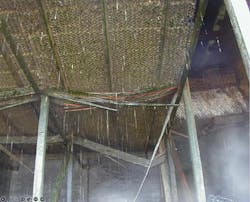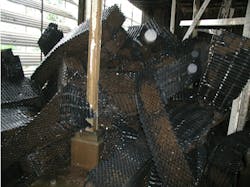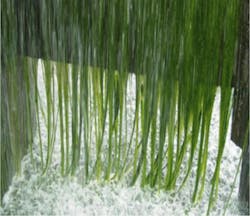Cooling Towers: A Critical but Often Neglected Plant Component – Part 2
3 Key Takeaways
- Microbiological growth in cooling towers can be extremely destructive, potentially causing catastrophic failures through mechanisms like biofilm formation, heat transfer inhibition and microbiologically induced corrosion. These microscopic organisms can create complex colonies that include aerobic, anaerobic and facultative bacteria, ultimately leading to potential complete system shutdown.
- Effective microbial control requires a sophisticated approach using both oxidizing and non-oxidizing biocides. While oxidizing biocides like chlorine and bromine are foundational, microorganisms can develop partial immunity to them. Alternative treatments like chlorine dioxide, monochloramine and periodic use of non-oxidizing biocides (such as DBNPA, isothiazolones and glutaraldehyde) can provide more comprehensive protection against microbial growth.
- The choice of biocide is critical and depends on multiple factors, including water conditions, pH, temperature and residence time. No single chemical is a universal solution, and industrial facilities must carefully select and rotate treatments to prevent microorganism immunity. Moreover, safety and environmental regulations must be strictly followed when implementing these chemical treatments.
In the hidden world of industrial cooling systems, a microscopic battle rages that can bring entire manufacturing facilities to a standstill. Building upon the fundamental cooling-tower operations and components explored in Part 1 of this series, we now examine the critical area of microbiological control, including excerpts and key points from the “Water Essentials Handbook.”
Microorganisms — invisible to the naked eye yet potentially very destructive when they form colonies— can transform a well-designed cooling tower (and other cooling system equipment) into a poorly operating mess. From the formation of bacterial biofilms to the insidious corrosion of metal surfaces, unchecked microbial growth represents a silent but serious threat to industrial operations.
Reliable cooling tower and cooling-system performance require conscientious chemistry control, using properly designed and maintained equipment.
Bio Growth Can Be Explosive
Microorganisms are pervasive throughout our environment. They live in the soil and water and travel by wind currents. The common conditions in cooling towers and cooling networks, warm and wet, are ideal for rapid microbiological growth, particularly bacteria. A well-designed and operated biocide feed system will kill free-floating (planktonic) organisms, but underperformance or feed-equipment failures can allow bacteria to settle, after which some will quickly begin forming a protective polysaccharide layer (slime) that can rapidly grow in depth and coverage, while collecting silt and debris. These are known as sessile deposits.
Microbiological Fouling Can Be Deadly
Legionella, first discovered in 1976 when it infected people attending an American Legion convention in Philadelphia, killed nearly three dozen people. The bacteria was present in water vapor exhaust from a cooling tower on the convention hotel roof. The vapor entered the intake of an air handling unit and spread through the hotel.
Colonies become complex, with aerobic microbes flourishing in upper layers, anaerobic bacteria deep within the deposit, and facultative organisms that can live with or without oxygen in between.
In addition, higher life forms often emerge from well-established microbiological colonies, including the deadly Legionella bacteria.
Microbiological fouling can inhibit heat transfer and water flow. A classic example is the collapse of the cooling tower fill support structure due to weight gain from microbial slime/silt accumulation. Figures 1 and 2 show such examples.
Additionally, deposits can establish corrosion cells where the area beneath the deposit becomes anodic to bare metal and begins to corrode. The presence of small anodes in a large cathodic field can generate pitting and through-wall penetration. Also, some bacteria such as the anaerobic sulfate-reducers release metabolic byproducts, in this case hydrogen sulfide, that are very destructive to many metals including steels. This attack is known as microbiologically induced corrosion (MIC).
Cooling-tower or heat-exchanger failure from waterside fouling and/or corrosion can potentially shut down a unit process or perhaps even the entire chemical or manufacturing facility.
Other potentially problematic microbes include algae and fungi. Algae (Figure 3) are photosynthetic organisms and grow in areas exposed to the sun, most notably the decks of crossflow cooling towers. Many crossflow towers have covered decks to block sunlight, but algae can appear in other sunlit areas.
Fungi are non-photosynthetic organisms. Yeast is one form of fungi, and some species are critical for food and beverage production. Fungi are also important organisms for many waste-treatment processes because they help decompose organic material. However, in industrial cooling water systems some fungi will attack cooling-tower wood. This concern has decreased over the years, as many newer towers are constructed of fiberglass-reinforced plastic (FRP) materials, which are resistant to fungal attacks. Also, fungi prefer mildly acidic environments and are less active in modern cooling water systems per typical operation within a moderately basic pH range.
Microorganism Control: Oxidizing Biocides
For most recirculating and once-through cooling waters, oxidizing biocides are the foundation of a microbial control program. In the United States, chlorine gas was the standard for drinking water and then cooling-water treatment for many years. One-ton cylinders became the common method of storage, but safety issues prompted many industrial plant personnel to switch to liquid sodium hypochlorite (NaOCl), typically industrial-grade bleach with a common active chlorine concentration of 12.5%.
An alternative method is on-site hypochlorite generation. On-site hypochlorite generation systems produce a mixed oxidant from three common consumables: water, salt and electricity. Saltwater electrolysis generates chlorine and some peroxide.
When chlorine is added to water, the following reaction occurs:
Cl2 + H2O ⇌ HOCl + HCl
Hypochlorous acid, HOCl, is the killing agent, and it functions by penetrating cell walls and then oxidizing internal cell components. The efficacy and killing power of the compound are greatly influenced by pH due to the equilibrium nature of HOCl in water.
HOCl ⇌ H+ + OCl–
OCl– is a much weaker biocide than HOCl, probably because the negative charge on the OCl– ion does not allow it to effectively penetrate cell walls.
The dissociation of HOCl dramatically increases in relation to rising pH. Because most modern cooling tower scale/corrosion treatment programs operate at an alkaline pH, often near or slightly above 8.0, straight chlorine chemistry may not be the best choice.
Additionally, chlorine reacts with some water impurities, which reduces the halogen’s effectiveness. Chlorine combines irreversibly with ammonia and many organic compounds. These losses are referred to as chlorine demand. From an environmental perspective, some halogenated organic compounds are considered harmful and whose concentrations may be regulated in the plant discharge permit.
For these reasons, alternative oxidizers have gained support. These include bromine, chlorine dioxide, monochloramine and non-halogens.
A Closer Look at Alternative Oxidizers
Bromine
A popular alternative has been bromine chemistry, where a chlorine oxidizer (bleach is the common choice) and sodium bromide (NaBr) are blended in a slipstream and injected into the cooling water.
HOCl + NaBr ⇌ HOBr + NaCl
The reaction produces hypobromous acid (HOBr), which has similar killing powers to HOCl but functions more effectively at alkaline pH. Bromine also has a halogen demand, but unlike chlorine the bromine-ammonia reaction is reversible. Bromine can also form halogenated organics, and these compounds may be of concern.
Halogen Stabilizers
Several chemical compounds are available that stabilize chlorine and bromine and then release the oxidizers gradually to provide more uniform distribution. The most common stabilizers are sulfamate, dimethylhydantoin and isocyanurates.
Chlorine Dioxide
Chlorine dioxide (ClO2) must be prepared on site via the reaction of either sodium chlorite (NaClO2) or sodium chlorate (NaClO3) with an additional oxidizing agent under acidic conditions. Chlorine dioxide is more expensive than the halogens, but modern production techniques have lowered the cost.
Chlorine dioxide exhibits a high degree of reaction selectivity, and it can penetrate biofilms to attack microbes. ClO2 selectivity makes it advantageous for other water treatment applications, including wastewater odor control.
Because chlorine dioxide exists as a gas in solution, it is easily stripped by passage through cooling towers. ClO2 should be introduced below the surface of the tower basin water, preferably near the inlet of the circulation pumps. Handling of the core compounds for chlorine dioxide production, which may include sulfuric acid, requires attention to safety, although modern ClO2 generators are typically designed with safety in mind.
Chloramines
Chloramines have served for microbial control in potable water systems for many years.
Monochloramine is the compound of interest for modern cooling water biofouling control, and technologies are now available to produce a pristine stream of NH2Cl for this purpose. When compared with sodium hypochlorite, monochloramine is less reactive but almost equally toxic. The reduced reactivity allows it to penetrate biofilms and attack underlying organisms. However, monochloramine generally needs a longer contact time than hypochlorite to achieve the desired results.
Peroxide Oxidants: Hydrogen Peroxide, Peracetic Acid, Percarbonic Acid
Several peroxide-based biocides/disinfectants are on the market, and all can produce the peroxide radical (OH·) as the reactive compound. The most common products are hydrogen peroxide, peracetic acid and percarbonic acid. Unlike chlorine dioxide, peroxides react indiscriminately with a wide array of compounds, including microbes. Oxygen is the byproduct of reactions or auto-decomposition of the biocide.
Peroxides react rapidly and do not have long residence times. Thus, their usefulness as a standard treatment may be limited. However, for periodic offline cleaning, peroxide is extremely effective at removing biofilms and other organic-based deposits, especially when used in combination with caustic, a surfactant, and at warm temperatures. A very informative paper on this subject was given at the 33rd Annual Electric Utility Chemistry Workshop in 2013.
Invasive Mollusks Wreak Havoc
When zebra mussels first entered Lake St. Clair near Detroit in the mid-1980s, they began to spread throughout Midwest and other waterways. The problem was accentuated by the ability of mussels to survive for perhaps two to three weeks out of water. Mussels attached themselves to recreational boats and were transported to other water bodies, where they then started new colonies in previously unfouled sources.
Fighting Immunity: Non-Oxidizing Biocides
Microorganisms can develop partial immunity to oxidizers. And, of course, the slime layer of sessile organisms consumes oxidizing compounds. Feed of a non-oxidizing biocide on a periodic basis, once or twice per week for an hour or so, can help to control microbial growth. Non-oxidizers damage cell walls and/or penetrate into cells to then react with metabolic compounds that are necessary for life. Some of the most common non-oxidizers include:
- 2,2-dibromo-3-nitrilopropionamide (DBNPA)
- Isothiazolones
- Glutaraldehyde
- Quaternary amines
No compound is a one-size-fits-all choice. Water conditions including pH, oxidizing biocide concentration, temperature, residence time and other factors can influence the efficacy of a chemical. Some are excellent bactericides, while others are better algaecides or fungicides.
Applications for these compounds are not completely limited to cooling water. DBNPA has proven to be effective in some applications for controlling microbiological growth in reverse osmosis systems used for high-purity makeup water treatment. Isothiazolones are, in very slight concentrations, a common anti-microbial agent in many detergents. The term shown on some product labels is “preservative.”
Highly important when handling these chemicals, as it should be for any chemical, is to precisely follow safety data sheet instructions, including use of the proper protective equipment. Anyone interested in even testing these compounds must receive permission from the proper environmental regulators. Subsequent permanent use normally requires modifications to the plant discharge permit to limit toxicity to aquatic life. Some compounds decompose rather rapidly, where the answer might be routing the discharge through a retention pond. Others could require an additional chemical feed to the discharge to neutralize any residual concentration.
Quaternary amines have served as biocides for cooling water macro foulants, such as clams and zebra mussels.
Juvenile organisms, which do not have fully formed shells, can be destroyed by oxidizing biocides. Adult colonies are a different story. The organisms survive by filtering water for food. When they sense an oxidizing biocide, they “clam up” until the threat is gone. Conversely, the animals cannot detect some of the non-oxidizing biocides, such as quaternary amines, and will continue to filter water as they are gradually poisoned.
Reliable and consistent biocide feed is critical for minimizing the formation of sessile deposits. Additional details from the Cooling Technology Institute and other references cited in this overview.
About the Author
Brad Buecker, SAMCO Technologies, Buecker & Associates, LLC
President, Buecker & Associates, LLC
Brad Buecker currently serves as senior technical consultant with SAMCO Technologies and is the owner of Buecker & Associates, LLC, which provides independent technical writing/marketing services. Buecker has many years of experience in or supporting the power industry, much of it in steam generation chemistry, water treatment, air quality control, and results engineering positions with City Water, Light & Power (Springfield, Illinois) and Kansas City Power & Light Company's (now Evergy) La Cygne, Kansas, station. His work also included 11 years with two engineering firms, Burns & McDonnell and Kiewit, and two years as acting water/wastewater supervisor at a chemical plant. Buecker has a B.S. in chemistry from Iowa State University with additional coursework in fluid mechanics, energy and materials balances, and advanced inorganic chemistry. He has authored or co-authored over 300 articles for various technical trade magazines, and he has written three books on power plant chemistry and air pollution control. He is a member of the ACS, AIChE, AIST, ASME, AWT, CTI, and he is active with Power-Gen International, the Electric Utility & Cogeneration Chemistry Workshop, and the International Water Conference.

Richard Aull
President and Principal Engineer
Richard Aull is president and principal engineer of Richard Aull Cooling Tower Consulting, LLC. He has been working in the cooling tower industry for over 40 years, with a specific interest in tower thermal design, performance rating, and analysis. Prior to starting his consulting business in 2017, he held technical positions within Brentwood Industries' cooling tower business unit, first as R&D manager and lastly as director of application engineering. Earlier in his career he held a variety of engineering positions within Research Cottrell's Hamon Cooling Tower Division and the Ecodyne Cooling Tower Services Group. Rich is active in the Cooling Technology Institute (CTI) and has published technical papers and conducted seminars on a variety of cooling tower topics.




